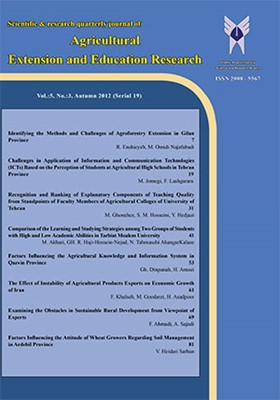-
-
List of Articles
-
Open Access Article
1 - Investigating the role of educational and social factors affecting the development of saffron business clusters in South Khorasan province
rayhaneh riyahi Sayed Mehdi Mirdamadi Seyed Jamal Hosseini Maryam Omidi najafabadi -
Open Access Article
2 - Determining Socio-Economic Factors for Contract Farming Success in Iran.
Hossein Hossein Abadi Amir Mohammadinejad omid gilanpoor mohammad khaledi -
Open Access Article
3 - Measuring staff’s job satisfaction of employees of Khuzestan Province Agricultural Jihad Organization Using the extended satisfaction model
bahman khosravipour Masoud Yazdanpanah Ameneh SavariMombeni Amine Lotfian -
Open Access Article
4 - Identifying the challenges and problems of agricultural higher education using grounded theory
فاطمه karimi etemad Jafar Yaghoubi Abdolhamid Papzan -
Open Access Article
5 - Explaining the mechanisms and strategies of agricultural development in the rural areas of Aqra/Aqra city, Dohuk province, Iraqi Kurdistan climate
Zohair Abdorahman علیرضا جمشیدی Vahid Mohamadnezhad -
Open Access Article
6 - Analyzing the factors influencing the acceptance of Canola (Brassica napus) cultivation in Boyar- Ahmad county: Application of integrated model of acceptance and using technology
hajar Aeen-Moghaddam Mostafa Ahmadvand Ayatollah Karami
-
The rights to this website are owned by the Raimag Press Management System.
Copyright © 2021-2025







